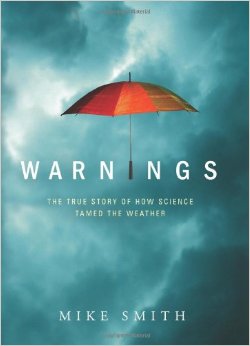“Warnings” – A Review
Most of you know I work a pretty long day… up before 5 a.m… not home until around midnight. My passion for weather keeps me going and energized. Unfortunately the long hours prevents me from reading many books, but I was able to finish “Warnings: The True Story of How Science Tamed the Weather” by my friend Mike Smith this month.
For those that love weather, this is one of those books that is hard to put down. Not only is it a history of the severe weather warning system in the United States, it also weaves in the personal story of Mike’s long career.
Most of us in applied meteorology had some event in our childhood that triggered a deep interest in weather. For Mike, it was the Ruskin Heights tornado on May 20, 1957, just south of Kansas City, that was rated EF-5, and would kill 44 people that Monday evening. There were no tornado warnings in 1957; the U.S. Weather Bureau had a fear that that would set off a panic if they even mentioned the immediate threat of a tornado. Mike describes watching news cut-ins during “I Love Lucy” on WDAF as reports came into their newsroom.
The book goes on to tell the story of the first operational tornado forecast had been issued by Air Force Officers E. J. Fawbush and R. C. Miller at Tinker Air Force Base in 1948. These men laid the foundation for the current watch and warning system in use today.
There are many case studies in Mike’s book; one of great interest to me is the mircoburst of August 2, 1985 that downed Delta Flight 191, a regularly scheduled service from Fort Lauderdale-Hollywood International Airport, Florida to Los Angeles International Airport, California, by way of Dallas-Fort Worth International Airport. The crash came on the ground of DFW Airport in Texas; I happened to be the chief meteorologist for the CBS station in Dallas at the time, KDFW-TV, Channel 4. The plane went down during the first few minutes of our 6:00 news that evening, and soon it become pretty clear the big thunderstorm near DFW was responsible for the crash, which would kill 137 people.
Guess I can admit it now, but watching the live news coverage of the crash that night on our competing station, WFAA-TV, had a big impact on me, and inspired me to do long form coverage during tornadoes later in my career when it was allowed by management. Channel 8 did such a good job that night.
Mike also look at the warning process for Hurricanes Andrew and Katrina in deep detail… what went right, and what went wrong. It is especially interesting to read the chapter “Murder by Bureaucracy” concerning Katrina.
I do believe you need to know where you have been to have a better understanding of where you are going. This history of severe weather warnings in this nation is a very important story for all of us, and Mike did a masterful job of telling it. I encourage all in the weather enterprise, and those interested in weather, to get a copy. It is a very good read.
Category: Hodgepodge



















